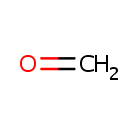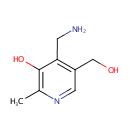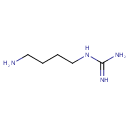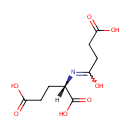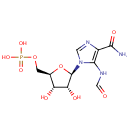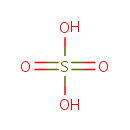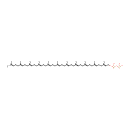
Search Results for compounds
Searching compounds for
returned 4373 results.
Formaldehyde (PAMDB000382)
IUPAC:
formaldehyde
CAS: 50-00-0
Description: Formaldehyde is a highly reactive aldehyde gas. It is the simplest aldehyde. Its chemical formula is H2CO. Although formaldehyde is a gas at room temperature, it is readily soluble in water, and it is most commonly sold as a 37% solution in water called by trade names such as formalin or formol. In water, formaldehyde polymerizes, and formalin actually contains very little formaldehyde in the form of H2CO monomer. Formaldehyde exhibits most of the general chemical properties of the aldehydes, except that is generally more reactive than other aldehydes. Formaldehyde is a potent electrophile. It can participate in electrophilic aromatic substitution reactions with aromatic compounds and can undergo electrophilic addition reactions with alkenes. In Pseudomonas aeruginosa, formaldehyde is formed by the breakdown of N-methyltryptophan and FMNH by their corresponding oxidases.
Phosphate (PAMDB000383)
IUPAC:
phosphate
CAS: 14265-44-2
Description: Phosphate is an inorganic chemical, is a salt of phosphoric acid. In organic chemistry, a phosphate, or organophosphate, is an ester of phosphoric acid. Organic phosphates are important in biochemistry and biogeochemistry or ecology. Phosphate (Pi) is an essential component of life. Phosphates are most commonly found in the form of adenosine phosphates, (AMP, ADP and ATP) and in DNA and RNA and can be released by the hydrolysis of ATP or ADP. Similar reactions exist for the other nucleoside diphosphates and triphosphates. Phosphoanhydride bonds in ADP and ATP, or other nucleoside diphosphates and triphosphates, contain high amounts of energy which give them their vital role in all living organisms. They are generally referred to as high energy phosphate.
Pyridoxamine (PAMDB000384)
IUPAC:
4-(aminomethyl)-5-(hydroxymethyl)-2-methylpyridin-3-ol
CAS: 85-87-0
Description: Pyridoxamine is the 4-aminomethyl form of vitamin B6. During transamination of amino acids, pyridoxal phosphate is transiently converted into pyridoxamine phosphate. -- Pubchem; Pyridoxamine is one of the compounds that can be called vitamin B6, along with Pyridoxal and Pyridoxine. -- Wikipedia
Agmatine (PAMDB000385)
IUPAC:
1-(4-aminobutyl)guanidine
CAS: 306-60-5
Description: Agmatine (also known as (4-aminobutyl)guanidine) is the decarboxylation product of the amino acid arginine and is an intermediate in polyamine biosynthesis. (Wikipedia) In Pseudomonas aeruginosa arginine metabolism, agmatine is produced from arginine in a reaction catalyzed by arginine decarboxylase (4.1.1.19). Another enzyme, agmatinase (EC 3.5.3.11), can then convert agmatine to putrescine, which is a polyamine that can be further converted to other products such as spermidine. (KEGG)
D-Mannose 1-phosphate (PAMDB000386)
IUPAC:
{[(3S,4S,5S,6R)-3,4,5-trihydroxy-6-(hydroxymethyl)oxan-2-yl]oxy}phosphonic acid
CAS: 27251-84-9
Description: D-Mannose 1-phosphate is a normal metabolite intermediate in the Fructose and mannose metabolism, and substrate of phosphomannomutase 1 (PMM, EC: 5.4.2.8), an enzyme necessary for the synthesis of GDP-mannose. PMM converts mannose 6-phosphate to mannose-1-phosphate, which is required for the synthesis of GDP-mannose, a substrate for dolichol-linked oligosaccharide synthesis.
N-Succinyl-L-glutamate (PAMDB000387)
IUPAC:
(2S)-2-[(3-carboxy-1-hydroxypropylidene)amino]pentanedioic acid
CAS: 33981-72-5
Description: N-succinyl-L-glutamate is a member of the chemical class known as Tricarboxylic Acids and Derivatives. These are organic compounds containing three carboxylic acid groups (or salt/ester derivatives thereof).
Phosphoribosyl formamidocarboxamide (PAMDB000388)
IUPAC:
{[(2R,3S,4R,5R)-5-(4-carbamoyl-5-formamido-1H-imidazol-1-yl)-3,4-dihydroxyoxolan-2-yl]methoxy}phosphonic acid
CAS: Not Available
Description: Phosphoribosyl formamidocarboxamide is an intermediate in purine metabolism, where it is the byproduct of phosphoribosylaminoimidazolecarboxamide formyltransferase (EC 2.1.2.3) and IMP cyclohydrolase (EC 3.5.4.10). It is also a byproduct of Ligases (EC 6.3.4.-).
dGTP (PAMDB000389)
IUPAC:
({[({[(2R,3S,5R)-5-(2-amino-6-oxo-6,9-dihydro-1H-purin-9-yl)-3-hydroxyoxolan-2-yl]methoxy}(hydroxy)phosphoryl)oxy](hydroxy)phosphoryl}oxy)phosphonic acid
CAS: 2564-35-4
Description: dGTP is one of the two purine nucleotides that are used to synthesize DNA. It is an intermediate in purine metabolism pathway. It is a product of anaerobic ribonucleoside-triphosphate reductase (EC:1.17.4.2) and a substrate of deoxyguanosine triphosphate triphosphohydrolase (EC:3.1.5.1). (KEGG)
Sulfate (PAMDB000391)
IUPAC:
sulfuric acid
CAS: 14808-79-8
Description: The sulfate ion is a polyatomic anion with the empirical formula SO42- and a molecular mass of 96.06 daltons; it consists of one central sulfur atom surrounded by four equivalent oxygen atoms in a tetrahedral arrangement. The sulfate ion carries a negative two charge and is the conjugate base of the hydrogen sulfate ion, HSO4-, which is the conjugate base of H2SO4, sulfuric acid. In inorganic chemistry, a sulfate (IUPAC-recommended spelling; also sulphate in British English) is a salt of sulfuric acid. Sulfate aerosols can act as cloud condensation nuclei and this leads to greater numbers of smaller droplets of water. Lots of smaller droplets can diffuse light more efficiently than just a few larger droplets.
Undecaprenyl diphosphate (PAMDB000394)
IUPAC:
{[hydroxy({[(2E,6E,10E,14E,18E,22E,26E,30E,34E,38E)-3,7,11,15,19,23,27,31,35,39,43-undecamethyltetratetraconta-2,6,10,14,18,22,26,30,34,38,42-undecaen-1-yl]oxy})phosphoryl]oxy}phosphonic acid
CAS: 23-13-2
Description: Undecaprenyl diphosphate belongs to the class of Polyprenyl Phosphates. These are prenol lipids in which the phosphate group is linked to one end of the polyprenol moiety. (inferred from compound structure)C55-isoprenyl pyrophosphate (undecaprenyl pyrophosphate) is an essential molecule involved in construction of the bacterial peptidoglycan cell wall. (WikiPedia)
